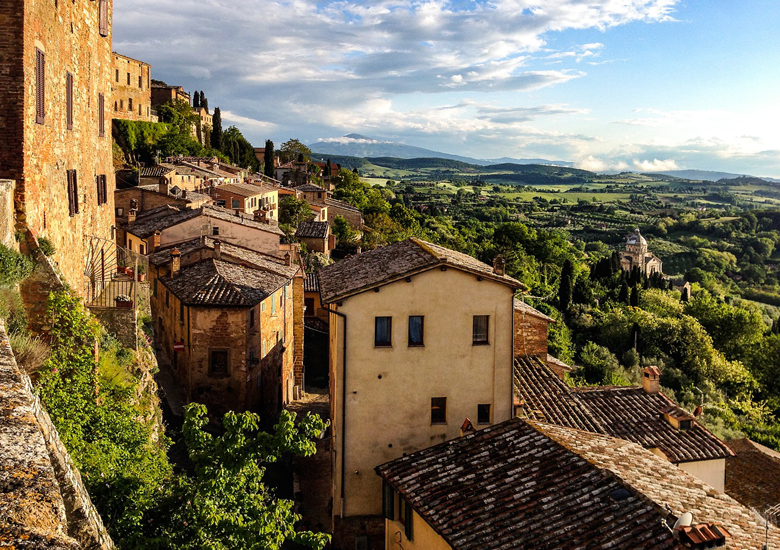Montepulciano is a medieval and Renaissance hill town and comune in the Italian province of Siena in southern Tuscany.
It sits high on a 605-metre (1,985 ft) limestone ridge, 13 kilometres (8 mi) east of Pienza, 70 kilometres (43 mi) southeast of Siena, 124 kilometres (77 mi) southeast of Florence, and 186 kilometres (116 mi) north of Rome by car.
Montepulciano is a major producer of food and drink. Renowned for its pork, cheese, “pici” pasta, lentils, and honey, it is known worldwide for its wine. Connoisseurs consider its Vino Nobile, which should not be confused with varietal wine merely made from the Montepulciano grape, among Italy’s best.
Access : Coordinates: / By car : Montepulciano is a few kms from the A1 Autostrada as well as the more scenic SS2 from Rome to Florence. By bus : Buses, departing from Piazza Pietro Nenni, connect Montepulciano with many other Tuscan cities: Siena (75 minutes, 4/day none on Sunday), Pienza (30 minutes, 8/day), Montalcino (1 hour 10/day, change in Torrenien) and Chiusi (hourly). Route #146 into Montepulciano is quite scenic. See Tuscany#Get_around for tips. If you are walking into town from the bus station (autostazione in Italian), there is a pedestrian short-cut with both an elevator and stairs to the top of the cliff. The entrance is through a portal on Via delle Lettere at the corner of Piazzale dello Sterro, about 50 m from the bus station.
By rail : The nearest railhead is a half hour away at Chiusi from where there are frequent trains to Florence and Rome.
Highlights :
- The main street of Montepulciano stretches for 1.5 kilometres (0.9 mi) from the Porta al Prato to the Piazza Grande at the top of the hill. The city is renowned for its walkable, car-free nature.Piazza Grande, the main square,Town Hall: Palazzo Comunale , Clock Tower ,City Walls, were built in 1511 , Cathedral, the duomo, or cathedral, dates from the early 17th century ,
The main landmarks include:
- The Palazzo Comunale, designed by Michelozzo in the tradition of the Palazzo della Signoria (Palazzo Vecchio) of Florence.
- Palazzo Tarugi, attributed to Antonio da Sangallo the Elder or Jacopo Barozzi da Vignola. It is entirely in travertine, with a portico which was once open to the public.
- The Cathedral of Santa Maria Assunta, or the Duomo of Montepulciano, constructed between 1594 and 1680, includes a masterpiece from the Sienese School, a massive Assumption of the Virgin triptych painted by Taddeo di Bartolo in 1401.
- The church of Santa Maria delle Grazie (late 16th century). It has a simple Mannerist facade with a three-arcade portico. The interior has a single nave, and houses a precious terracotta altar by Andrea della Robbia.
- The Sanctuary of the Madonna di San Biagio is on the road to Chianciano outside the city. It is a typical 16th century Tuscan edifice, designed by Antonio da Sangallo the Elder on a pre-existing Pieve, between 1518 and 1545. It has a circular (central) plan with a large dome over a terrace and a squared tambour. The exterior, with two bell towers, is built in white travertine.
- Baroque church of Santa Lucia has an altarpiece by Luca Signorelli.
The walls of the city date to around the 14th century.
Activities : sightseeing / photo opportunities / trekking
Go next :

